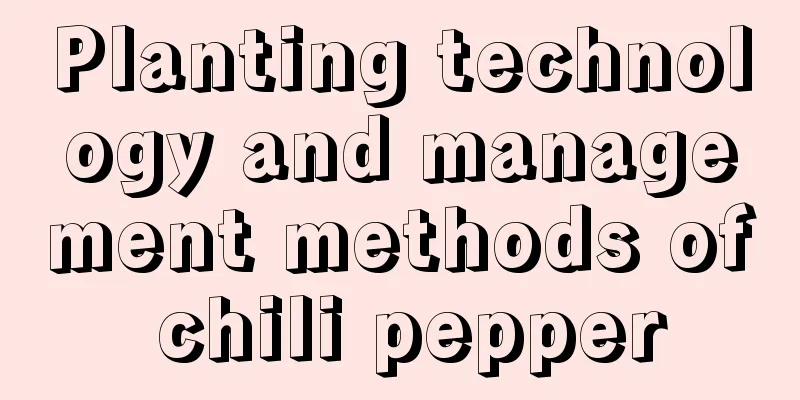Planting technology and management methods of chili pepper

|
In recent years, the demand for peppers in the market has been stable and the prices have been relatively high, making it a choice for many farmers to increase their income. For farmers who intend to grow chili peppers, it is crucial to understand the correct planting methods. Let’s learn about the planting techniques and management methods of chili peppers. 1. Planting time Chili pepper is mainly planted in the open field. For example, spring planting in Henan Province usually starts in April. Intercropping of chili peppers with wheat stubble is usually carried out in May, and the ground temperature and wheat harvest time must be taken into consideration. The appropriate planting time should be when the temperature at a depth of 5 cm in the soil reaches above 15°C to ensure root development and later growth. The planting of chili peppers in wheat fields should be avoided too early or too late to avoid affecting the wheat harvest and the growth of chili peppers. It is recommended to do it in May to ensure a sufficient growth cycle. 2. Planting density The yield of chili pepper is closely related to the planting density. Reasonable density helps to increase the yield per unit area. The planting density should be determined according to the characteristics of the selected varieties. Large varieties or varieties with dense branches are suitable for sparse planting, while varieties suitable for dense planting should have their planting density determined according to their characteristics. Adjust planting density according to variety characteristics and growth habits to achieve optimal ventilation and light conditions and field management effects. 3. Temperature and humidity management Chili pepper prefers a warm environment, and the suitable growth temperature is about 25℃. It is not cold-resistant, so it needs to be planted in warm seasons or in a greenhouse. It likes dry environment and the relative humidity of the air should be kept at around 50% to avoid diseases caused by high humidity. 4. Water and Fertilizer Management During the seedling stage, focus on applying phosphorus fertilizer and nitrogen fertilizer to promote rapid growth of seedlings. After planting, the fertilizer applied is mainly phosphorus fertilizer and potassium fertilizer to help the chili pepper bloom and bear fruit. Spray nitrogen, phosphorus and potassium compound fertilizer in the later growth stage to extend the functional period of leaves and prevent premature aging. The chili pepper does not require much water. Only water it moderately when the leaves wilt, and avoid frequent irrigation. 5. Pest and disease control Disease prevention and control: control the amount of watering, keep the garden clean, and use amide fungicides for chemical control. "Three falls" phenomenon: spray tetrachloroisophthalonitrile mixture regularly and use fungicides after rain to prevent germs. Aphid control: Spray nitromethylene systemic insecticides to effectively control aphid damage. In general, as a popular pepper variety, the cultivation of chili pepper requires careful management of temperature and humidity, water and fertilizer, as well as disease and pest control. Through the above measures, a good growth environment can be created for chili peppers to ensure a good harvest of chili peppers.
|
>>: Taboos for planting lemon trees in pots at home
Recommend
When to grow eggplant and pepper seedlings?
Eggplant and pepper are both Solanaceae crops. Wh...
How to save seeds of lotus
How to get lotus seeds Dryopteris belongs to the ...
When is the best time to plant winter vegetables?
There is a kind of vegetable that is particularly...
Can the aerial roots of Kalanchoe survive when planted in the soil? How to plant aerial roots in the soil?
Kalanchoe has strong vitality, and both branches ...
Rely on these 7 points to grow flowers in autumn. Once you learn them, your pots will be full of flowers!
Cuttings The temperature drops in autumn, which i...
What are the breeding methods and precautions of colorful iron
Seven-color iron breeding method The colorful iro...
Does Gypsophila need watering every day?
Do you water your baby's breath every day? In...
Where do cherries grow?
Cherries are relatively small in size, with beaut...
What fertilizer is best for growing broad beans? What fertilizer is needed for broad bean base fertilizer?
What is the best fertilizer for broad beans? Broa...
Artificial pollination of Strelitzia reginae
Time for artificial pollination of Strelitzia The...
Common pests of Aglaonema and their control
Pests of Fagus sylvatica - Red spider Red spider ...
Water and Fertilizer Management of Magnolia
Water Management in Magnolia Magnolia likes moist...
How often should I water the caltrop?
How often should I water the caltrop? Water the o...
How to take care of the newly bought fortune tree
1. Moderate light A newly purchased money tree is...
Where does creeper grow? Can it survive the winter in the north?
1. Where is it located? Ivy can grow in a wide ra...









